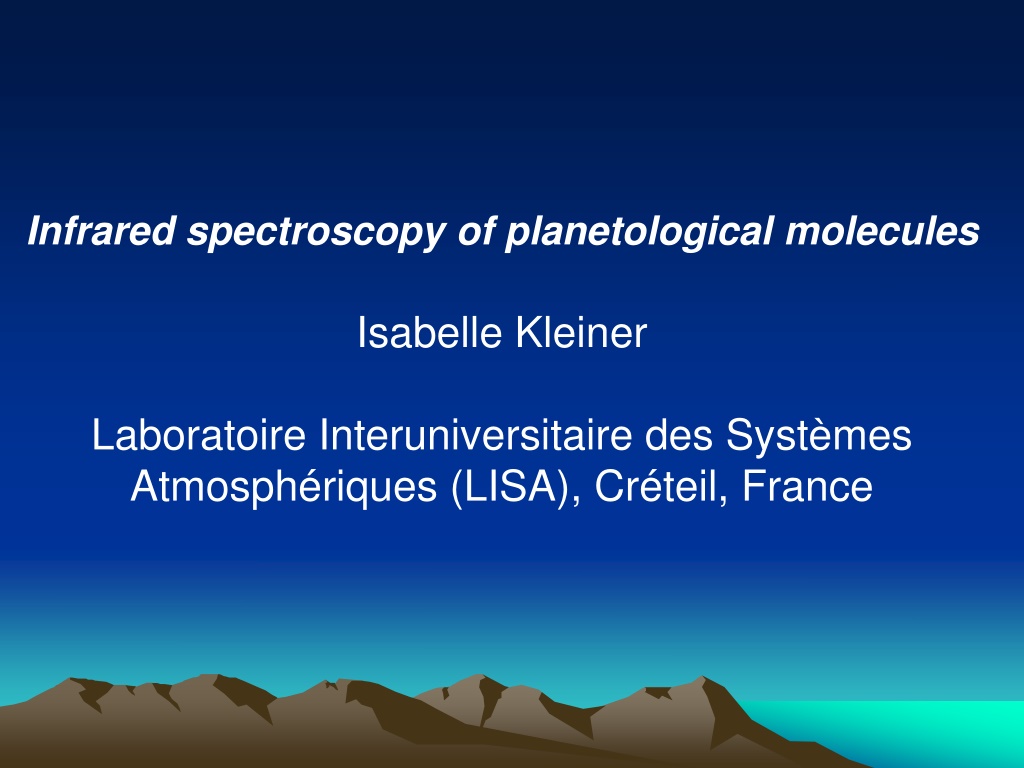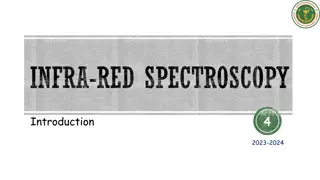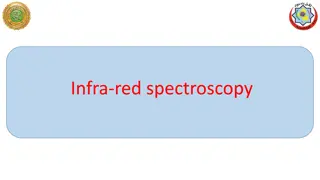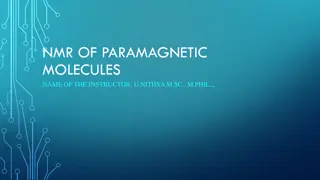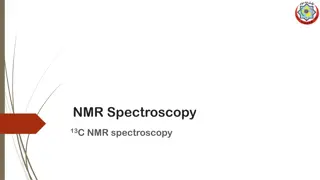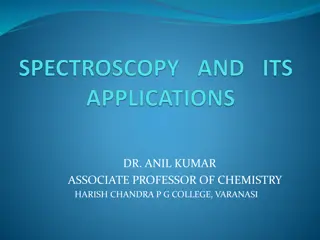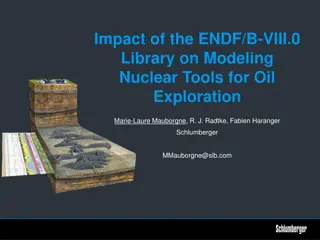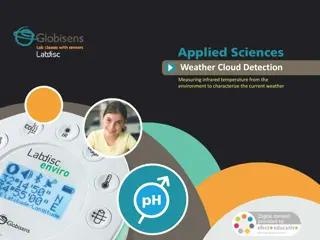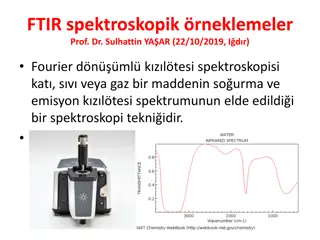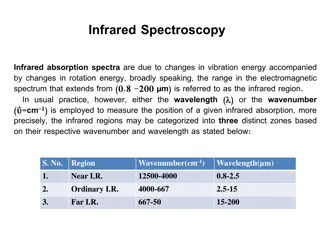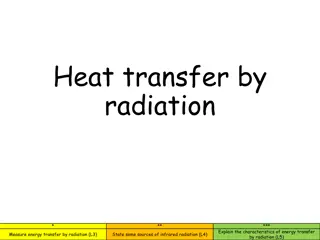Insights into Infrared Spectroscopy of Planetary Molecules and Space Exploration
Infrared spectroscopy plays a crucial role in studying planetary molecules like NH3, PH3, and CH3CN, aiding in planetary observations and spacecraft missions. Ground-based observatories and spacecraft like GALILEO and Cassini/Huygens provide valuable data for analyzing planetary spectra and modeling gas phase molecules. Strategies involve obtaining experimental data and employing theoretical approaches to understand line positions, intensities, and energy parameters. This research also sheds light on the characteristics of giant planets and their atmospheres.
Download Presentation

Please find below an Image/Link to download the presentation.
The content on the website is provided AS IS for your information and personal use only. It may not be sold, licensed, or shared on other websites without obtaining consent from the author. Download presentation by click this link. If you encounter any issues during the download, it is possible that the publisher has removed the file from their server.
E N D
Presentation Transcript
Infrared spectroscopy of planetological molecules Isabelle Kleiner Laboratoire Interuniversitaire des Syst mes Atmosph riques (LISA), Cr teil, France
Summary Planetary observations Strategy and methods Molecular systems: NH3, PH3, CH3CN, 13CH3D
-Orbiting Spacecraft : GALILEO: observations of Venus (1990) : 3 CO2 4.3 m mission to Jupiter (1996), Probe : first in-situ observations ! GOOD SPATIAL RESOLUTION NIMS : Near Infrared Mapping Spectrometer Grating spectrometer, 0.7-5.2 m R = 0.0125 m < 1 m ; 0.025 m > 1 m
Planetary observations -Ground based observatories: Canada-France-Hawaii Telescope (CFHT)
Cassini/Huygens Study of Saturnian system, launched 1997 Flew past Jupiter on december 2000 Go into orbit of saturn in july 2004 ESA entry probe Huygens in Titan atmosphere 14/01/2005 -Visible and Infrared Mapping Spectrometer (VIMS) 0.35-1.07 m; visible 0.85-5.1 m; IR -Composite Infrared Spectrometer (CIRS) 10-1400 cm-1 Interferometers, Resolution 0.5 cm-1
WHAT DO WE NEED FOR ANALYZING PLANETARY SPECTRA? Basic transition line parameters: Line position (or center frequency) Line intensity at 296 K Lower state energy (for temperature dependence) Vibrational - rotational quantum assignment Line shape parameters (Voigt) self-broadening coefficients, pressure brodening, line mixing
How to model the IR spectra of NH3 ,PH3 , C3H8 in the gas phase? STRATEGY USED 1) First step : obtain experimental data for both line positions and line intensities of pure 14NH3 , PH3, in the lab. 2) Analyze the data using an appropriate theoretical approach : taking into account : - inversion motion of NH3 , - different interactions between energy levels for NH3 and PH3. best energy and intensity parameters obtained complete line-by-line prediction with all information needed.
NH3 and PH3: Giant Planets -Largest planetary bodies in solar system (99.56% of the planetary mass) Gas giants : H2 and He : Jupiter Saturn ice giants : ices of water and CH4 : Uranus Neptune Mean temperatures at 1 bar : Jupiter: 167 K; Saturn: 138 K (Uranus:79K,Neptune : 70K)
3 microns spectral range: Saturn and Jupiter have very different spectra NH3 ice cloud PH3 : NEED FOR SPECTROSCOPIC DATA !
Phosphine is a molecule of astrophysical and astronomical interest and has been observed in both the Jupiter and Saturn atmospheres Between 800-300 K: 4PH3 + 6H2O P4O6 +12H2 At the cold temperatures of upper troposphere should not be detectable PH3 : A non-equilibrium species BUT vertical mixing transports PH3 faster than oxidation. PH3 abundance gives information on vertical circulation
Development of the theoretical model and programs for fitting the IR spectra of C3vmolecules 2 2 2+ 4 l4 2 4 l4 1 3 l3 K-type 2 2 Coriolis Coriolis Fermi Fermi Coriolis interaction Diag 2+ 4 l- type interaction Diag Coriolis Fermi Coriolis Fermi 2 42 l- type interaction Diag Coriolis Fermi Coriolis Fermi 1 K-type Interaction Diag Coriolis 3 l- type interaction Diag
Recent works on PH3 - A computed room temperature line list for phosphine, Clara Sousa-Silva, Sergei N. Yurchenko, Jonathan Tennyson, J. Mol. Spectrosc. 288 (2013) using the TROVE program Spectroscopic parameters of phosphine, PH3, in its ground vibrational state, Holger S.P. Muller, JQSRT, 130, 335 (2013) Global calculations using potential functions and effective Hamiltonian models for vibration-rotation spectroscopy, V.Tuyterev, M. Rey, in preparation Line Positions and Intensities of the Phosphine (PH3) Pentad near 4.5 microns V. Malathy Devia, Isabelle Kleiner, Robert L. Sams, Linda R. Brown, D. Chris Benner, Leigh N. Fletcher, J. Mol. Spectrosc.,298, 11 23 (2014) -Line shape parameters of PH3 transitions in the pentad near 4-5 micron; self-broadened widths, line mixing and speed dependence, V. M. Devi, D. C. Benner, I. Kleiner, R. L. Sams and L. N. Fletcher, J. Mol. Spectrosc. 302, 17 33 (2014)
-The band 3 2: -Low resolution of line positions (Maki et al. JCP 1973) - The octad bands: New line positions and intensities measurements (Butler , Brown, Kleiner et al., JMS 2006) The Global analysis of the Dyad, pentad and octad bands: (Nikitin, Brown, Kleiner et al., JMS 2009) The 2 2/ 2+ 4/2 4/ 1/ 3pentad: -Frequencies: rms=0.009 cm-1up to J=16 (Tarrago et al. JMS, 1992, Ulenikov and al. JMS, 2002) -Intensities: rms= 13% (Tarrago et al. JMS, 1992 NEW MEASUREMENTS NEEDED The 2/ 4dyad: -Frequencies: rms=0.0004cm-1up to J=22 (Fusina and al, J.Mol.Struc.,2000 ) -Intensities: rms=2% -Linewidth: self Broadening coefficients (J. Salem and al, JMS, 2004) (Brown, Kleiner and al., JMS, 2001)
